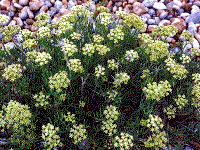 |
APIACEAE (formerly UMBELLIFERAE) - The Celery Family
There are between 2500 and 3000 members of this family, found all over the world, but mainly in the temperate areas and rarely in tropical regions. Some well-known vegetables and herbs are in this family (Carrot, Parsnip, Celery, Fennel, Angelica) some are familiar weeds of hedgerows and woodland (Cow Parsley, Hogweed), and some are grown as ornamental garden plants (Eryngium, Astrantia, Aciphylla), although these mainly do not look like umbellifers at all. Some are poisonous, notably Hemlock. |
Characteristics of this Plant Family:
Leaves, Stem & Roots ~ Most members of this Family are soft-stemmed annuals, biennials or perennials, although some grow tough stems and there are a few woody tree-like or shrubby species in tropical regions. Several species are prickly (Eryngium, Aciphylla). The stems are hollow between the leaf-joints, often ribbed (Angelica, Celery), and the leaves themselves are alternate, usually divided or pinnate, sometimes very like a fern. Sometimes they may be bluish (Eryngium).
Flowers ~ It is the flowers which gave this plant family its original name of Umbelliferae. The flowers grow in umbels or clusters forming an umbrella shape. The flowers have stalks of different lengths so that all the flowers are the same height so that the umbel has a flat top. The flower head may be a single umbel or many smaller umbels making up a large 'flower'. Each individual flower has five petals and five stamens, and they are generally small and insignificant, even in an umbel. The outer flowers may have some larger and some smaller petals. They are very often white, sometimes cream, yellow or pink.. The outer flowers open first. The flower stalk arises from the leaf axil. The overall appearance of many umbels is unimposing, as they are generally relatively tall and leggy.
The members of this Family grown for ornament often have flowers very different from the normal type. In Eryngium (Sea Holly) and Astrantia (Masterwort), it is the large bracts surrounding the umbel which are coloured and the flowers themselves are insignificant.
Recently, the international panel of botanists who rule on these things decided that all plant families ought to have the same ending (-aceae), and be named after a plant typical of the family, so the family is now called Apiaceae after the type plant, Apium (Celery).
Seeds ~ The seed capsule in this Family is behind the petals (inferior). The seed capsule has two parts with a single seed in each part. The seeds themselves are of many different shapes and sizes. They may be spiny, hooked or winged. Some are of culinary or medicinal use (Dill, Coriander, Cumin, Anise).
Members of this Family usually have:
Hollow stems
Small flowers in umbels
Flowers with five petals
White, yellow or pink (not blue) flowers